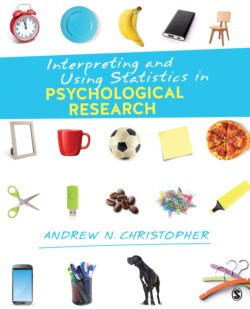Читать книгу Interpreting and Using Statistics in Psychological Research - Andrew N. Christopher - Страница 23
На сайте Литреса книга снята с продажи.
Goal: To Explain
ОглавлениеExplanatory research takes descriptive and predictive research one step further; that is, explanatory research (also called experimental research) allows researchers to draw cause-and-effect conclusions between phenomena of interest. The researcher uses “control” to establish cause-and-effect conclusions. By “control” in the context of explanatory research, a researcher must manipulate (i.e., control) some aspect of behavior. The behavior that is controlled is called the independent variable. In this example, the independent variable is level of aerobic exercise. It is “independent” because the researchers can decide, within ethical boundaries, what to expose participants to in the experiment. It is called “variable” because some participants engaged in aerobic exercise, and others did not. Had all participants engaged in aerobic exercise, there would be nothing that varied. There must be at least two groups created by manipulating (controlling) an independent variable. Without at least two groups, you would have no way to make a comparison on how people’s behavior was affected.5
Of course, we want to know an outcome of the independent variable. That outcome is called the dependent variable. That is, are there differences in academic performance based on whether people engaged in aerobic exercise? Such potential differences “depend” on the independent variable.
You might well be wondering at this point how we can draw cause-and-effect conclusions from the independent variable’s effect on the dependent variable. Researchers use random assignment of participants in the sample either to engage in aerobic exercise or not to engage in aerobic exercise. Think about the many ways people differ from one another. For instance, I grew up during the relative economic boom years of the 1980s in the North Dallas suburbs, raised by parents from the northeastern United States. Such an upbringing may well differ from yours, likely in more than one way. And that’s just a couple of ways we might differ from each other. Not that such differences are unimportant, but in this context, they are not of interest to the researchers. Therefore, we want to control for their influence on how people in the sample behave, so that we can isolate the effect of the independent variable. Through the process of random assignment, we can minimize the influences of variables (e.g., where people grew up, when people grew up, and socioeconomic status) other than the independent variable. In doing so, any effects we find can be linked to the independent variable.
Suppose we find that students who engaged in aerobic exercise throughout the semester had higher grades at the end of that semester. By using experimentation, which involves manipulating at least one variable, and by using random assignment of participants to groups created by that manipulation, we can draw cause-and-effect conclusions between behaviors. We will explore statistical tools that are often used with experimental data in Chapters 7 through 11.
Explanatory research: draws cause-and-effect relationships between variables.
Independent variable: variable that a researcher manipulates (changes) to create experimental groups (conditions). It should affect subsequent behavior or mental processes.
Dependent variable: behavior that results from the independent variable.
Random assignment: uses a random process, such as flipping a coin, to put members of a sample in one of the groups (conditions) in an experiment. Its purpose is to minimize preexisting differences among members of the sample so that researchers can be confident of the effects of the independent variable.
